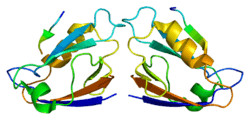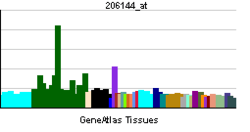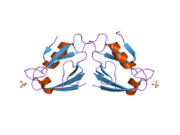MAGI1
Membrane-associated guanylate kinase, WW and PDZ domain-containing protein 1 is an enzyme that in humans is encoded by the MAGI1 gene.[1][2][3]
The protein encoded by this gene is a member of the membrane-associated guanylate kinase homologue (MAGUK) family. MAGUK proteins participate in the assembly of multiprotein complexes on the inner surface of the plasma membrane at regions of cell–cell contact. The product of this gene may play a role as scaffolding protein at cell–cell junctions. Alternatively spliced transcript variants encoding different isoforms have been identified.[3]
Interactions
MAGI1 has been shown to interact with Calcium-activated potassium channel subunit alpha-1,[4]Beta-catenin,[5] Actinin alpha 4,[6] Brain-specific angiogenesis inhibitor 1,[1] LRP2,[7] SYNPO,[6] FCHSD2,[8] ATN1[9] and ACCN3.[10]
References
- ↑ 1.0 1.1 Shiratsuchi T, Futamura M, Oda K, Nishimori H, Nakamura Y, Tokino T (July 1998). "Cloning and characterization of BAI-associated protein 1: a PDZ domain-containing protein that interacts with BAI1". Biochem Biophys Res Commun 247 (3): 597–604. doi:10.1006/bbrc.1998.8603. PMID 9647739.
- ↑ Margolis RL, Abraham MR, Gatchell SB, Li SH, Kidwai AS, Breschel TS, Stine OC, Callahan C, McInnis MG, Ross CA (July 1997). "cDNAs with long CAG trinucleotide repeats from human brain". Hum Genet 100 (1): 114–22. doi:10.1007/s004390050476. PMID 9225980.
- ↑ 3.0 3.1 "Entrez Gene: MAGI1 membrane associated guanylate kinase, WW and PDZ domain containing 1".
- ↑ Ridgway, LD; Kim EY; Dryer SE (July 2009). "MAGI-1 interacts with Slo1 channel proteins and suppresses Slo1 expression on the cell surface.". Am J Physiol Cell Physiol. (UNITED STATES) 297 (1): C55–65. doi:10.1152/ajpcell.00073.2009. PMID 19403801.
- ↑ Dobrosotskaya, I Y; James G L (April 2000). "MAGI-1 interacts with beta-catenin and is associated with cell-cell adhesion structures". Biochem. Biophys. Res. Commun. (UNITED STATES) 270 (3): 903–9. doi:10.1006/bbrc.2000.2471. ISSN 0006-291X. PMID 10772923.
- ↑ 6.0 6.1 Patrie, Kevin M; Drescher Andrew J; Welihinda Ajith; Mundel Peter; Margolis Ben (August 2002). "Interaction of two actin-binding proteins, synaptopodin and alpha-actinin-4, with the tight junction protein MAGI-1". J. Biol. Chem. (United States) 277 (33): 30183–90. doi:10.1074/jbc.M203072200. ISSN 0021-9258. PMID 12042308.
- ↑ Patrie, K M; Drescher A J; Goyal M; Wiggins R C; Margolis B (April 2001). "The membrane-associated guanylate kinase protein MAGI-1 binds megalin and is present in glomerular podocytes". J. Am. Soc. Nephrol. (United States) 12 (4): 667–77. ISSN 1046-6673. PMID 11274227.
- ↑ Ohno, Hideki; Hirabayashi Susumu, Kansaku Ai, Yao Ikuko, Tajima Makiko, Nishimura Wataru, Ohnishi Hirohide, Mashima Hirosato, Fujita Toshiro, Omata Masao, Hata Yutaka (November 2003). "Carom: a novel membrane-associated guanylate kinase-interacting protein with two SH3 domains". Oncogene (England) 22 (52): 8422–31. doi:10.1038/sj.onc.1206996. ISSN 0950-9232. PMID 14627983.
- ↑ Wood, J D; Yuan J; Margolis R L; Colomer V; Duan K; Kushi J; Kaminsky Z; Kleiderlein J J; Sharp A H; Ross C A (June 1998). "Atrophin-1, the DRPLA gene product, interacts with two families of WW domain-containing proteins". Mol. Cell. Neurosci. (UNITED STATES) 11 (3): 149–60. doi:10.1006/mcne.1998.0677. ISSN 1044-7431. PMID 9647693.
- ↑ Hruska-Hageman, Alesia M; Benson Christopher J; Leonard A Soren; Price Margaret P; Welsh Michael J (November 2004). "PSD-95 and Lin-7b interact with acid-sensing ion channel-3 and have opposite effects on H+- gated current". J. Biol. Chem. (United States) 279 (45): 46962–8. doi:10.1074/jbc.M405874200. ISSN 0021-9258. PMID 15317815.
Further reading
- Pirozzi G; McConnell SJ; Uveges AJ et al. (1997). "Identification of novel human WW domain-containing proteins by cloning of ligand targets". J. Biol. Chem. 272 (23): 14611–6. doi:10.1074/jbc.272.23.14611. PMID 9169421.
- Dobrosotskaya I, Guy RK, James GL (1998). "MAGI-1, a membrane-associated guanylate kinase with a unique arrangement of protein-protein interaction domains". J. Biol. Chem. 272 (50): 31589–97. doi:10.1074/jbc.272.50.31589. PMID 9395497.
- Wood JD; Yuan J; Margolis RL et al. (1998). "Atrophin-1, the DRPLA gene product, interacts with two families of WW domain-containing proteins". Mol. Cell. Neurosci. 11 (3): 149–60. doi:10.1006/mcne.1998.0677. PMID 9647693.
- Dobrosotskaya IY, James GL (2000). "MAGI-1 interacts with beta-catenin and is associated with cell-cell adhesion structures". Biochem. Biophys. Res. Commun. 270 (3): 903–9. doi:10.1006/bbrc.2000.2471. PMID 10772923.
- Patrie KM; Drescher AJ; Goyal M et al. (2001). "The membrane-associated guanylate kinase protein MAGI-1 binds megalin and is present in glomerular podocytes". J. Am. Soc. Nephrol. 12 (4): 667–77. PMID 11274227.
- Dobrosotskaya IY (2001). "Identification of mNET1 as a candidate ligand for the first PDZ domain of MAGI-1". Biochem. Biophys. Res. Commun. 283 (4): 969–75. doi:10.1006/bbrc.2001.4880. PMID 11350080.
- Laura RP, Ross S, Koeppen H, Lasky LA (2002). "MAGI-1: a widely expressed, alternatively spliced tight junction protein". Exp. Cell Res. 275 (2): 155–70. doi:10.1006/excr.2002.5475. PMID 11969287.
- Patrie KM; Drescher AJ; Welihinda A et al. (2002). "Interaction of two actin-binding proteins, synaptopodin and alpha-actinin-4, with the tight junction protein MAGI-1". J. Biol. Chem. 277 (33): 30183–90. doi:10.1074/jbc.M203072200. PMID 12042308.
- Strausberg RL; Feingold EA; Grouse LH et al. (2003). "Generation and initial analysis of more than 15,000 full-length human and mouse cDNA sequences". Proc. Natl. Acad. Sci. U.S.A. 99 (26): 16899–903. doi:10.1073/pnas.242603899. PMC 139241. PMID 12477932.
- Ohno H; Hirabayashi S; Kansaku A et al. (2003). "Carom: a novel membrane-associated guanylate kinase-interacting protein with two SH3 domains". Oncogene 22 (52): 8422–31. doi:10.1038/sj.onc.1206996. PMID 14627983.
- Ota T; Suzuki Y; Nishikawa T et al. (2004). "Complete sequencing and characterization of 21,243 full-length human cDNAs". Nat. Genet. 36 (1): 40–5. doi:10.1038/ng1285. PMID 14702039.
- Hruska-Hageman AM; Benson CJ; Leonard AS et al. (2004). "PSD-95 and Lin-7b interact with acid-sensing ion channel-3 and have opposite effects on H+- gated current". J. Biol. Chem. 279 (45): 46962–8. doi:10.1074/jbc.M405874200. PMID 15317815.
- Wright GJ, Leslie JD, Ariza-McNaughton L, Lewis J (2005). "Delta proteins and MAGI proteins: an interaction of Notch ligands with intracellular scaffolding molecules and its significance for zebrafish development". Development 131 (22): 5659–69. doi:10.1242/dev.01417. PMID 15509766.
- Benzinger A; Muster N; Koch HB et al. (2005). "Targeted proteomic analysis of 14-3-3 sigma, a p53 effector commonly silenced in cancer". Mol. Cell Proteomics 4 (6): 785–95. doi:10.1074/mcp.M500021-MCP200. PMID 15778465.
- Mizuhara E; Nakatani T; Minaki Y et al. (2005). "MAGI1 recruits Dll1 to cadherin-based adherens junctions and stabilizes it on the cell surface". J. Biol. Chem. 280 (28): 26499–507. doi:10.1074/jbc.M500375200. PMID 15908431.
- Patrie KM (2005). "Identification and characterization of a novel tight junction-associated family of proteins that interacts with a WW domain of MAGI-1". Biochim. Biophys. Acta 1745 (1): 131–44. doi:10.1016/j.bbamcr.2005.05.011. PMID 16019084.
- Bratt A; Birot O; Sinha I et al. (2005). "Angiomotin regulates endothelial cell-cell junctions and cell motility". J. Biol. Chem. 280 (41): 34859–69. doi:10.1074/jbc.M503915200. PMID 16043488.
- Sakurai A; Fukuhara S; Yamagishi A et al. (2006). "MAGI-1 is required for Rap1 activation upon cell-cell contact and for enhancement of vascular endothelial cadherin-mediated cell adhesion". Mol. Biol. Cell 17 (2): 966–76. doi:10.1091/mbc.E05-07-0647. PMC 1356604. PMID 16339077.
| |||||||||


